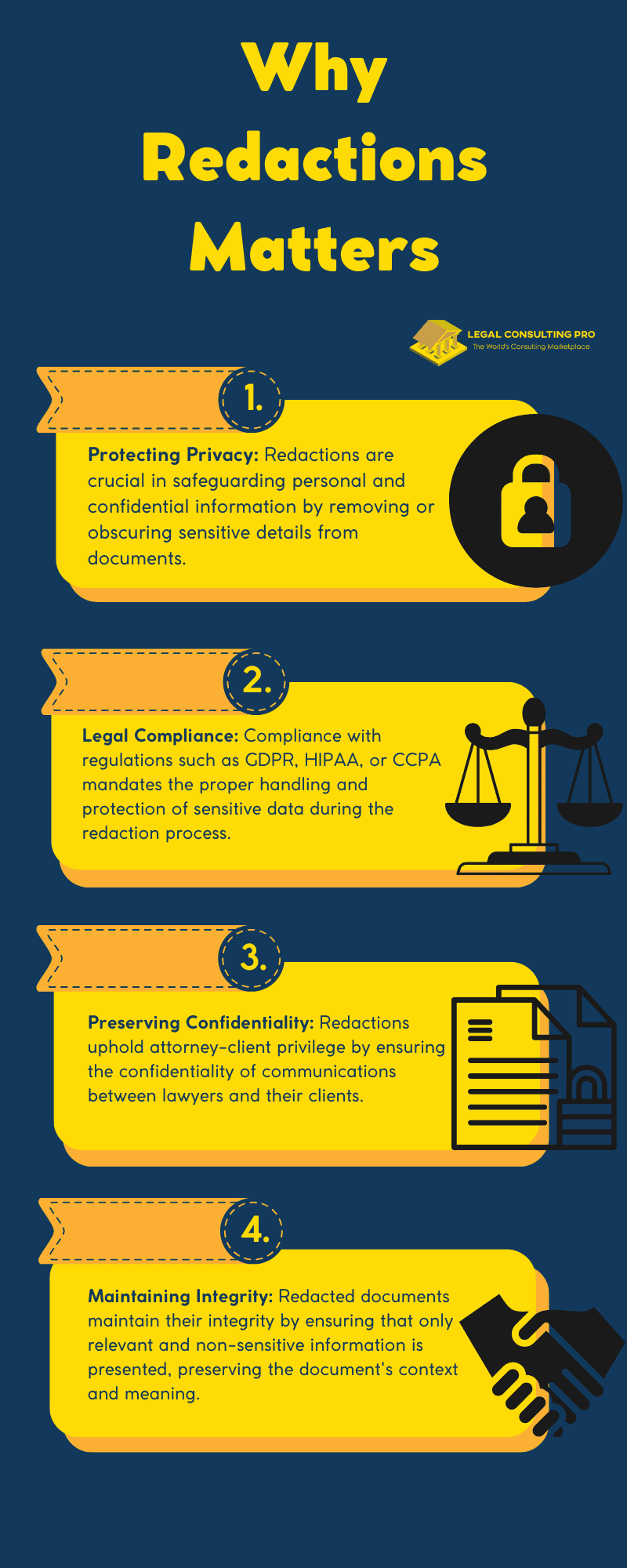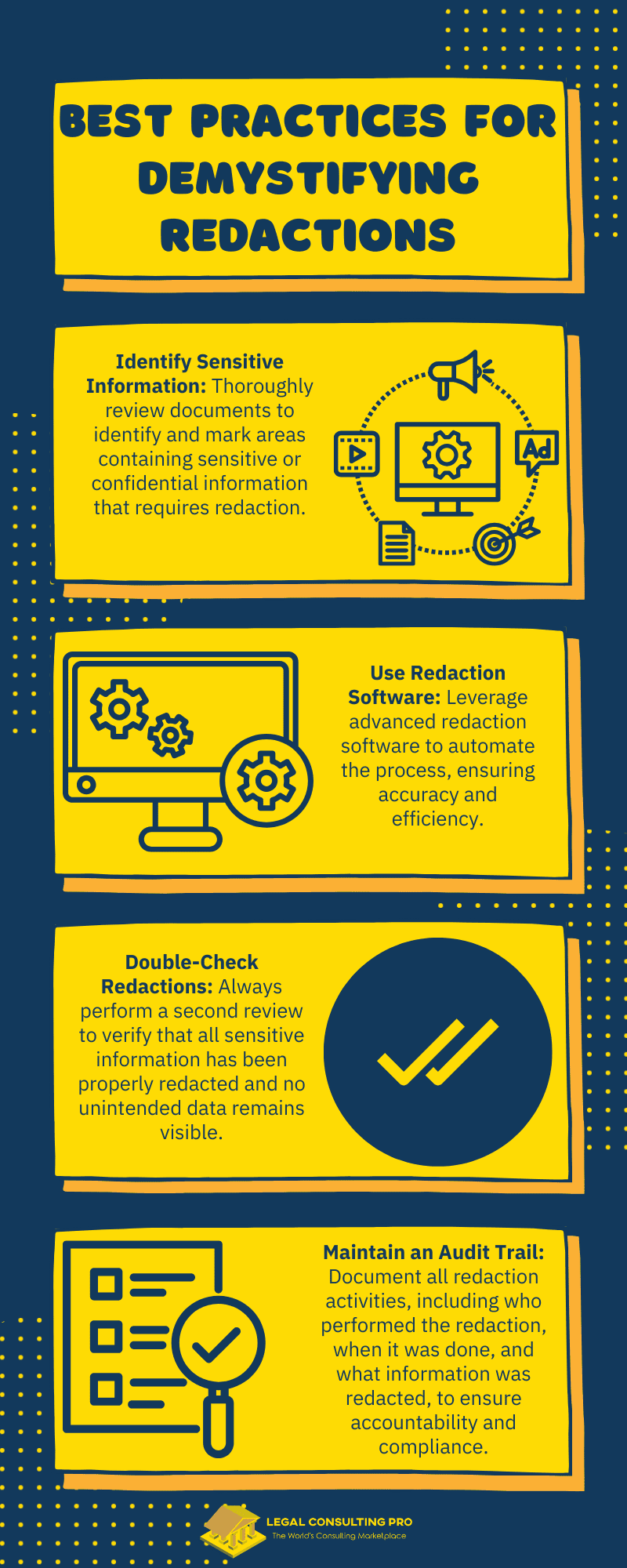In today’s digital age, the protection of sensitive information is more crucial than ever. Legal documents often contain confidential or privileged details that, if exposed, can compromise privacy, violate regulations, or jeopardize ongoing litigation. This is where redaction processes come into play. While redactions are a fundamental aspect of document management in the litigation support services field, many clients and stakeholders may find the concept complex or intimidating. This article aims to demystify redaction processes, shedding light on their importance, methods, and the role of litigation support services in ensuring effective redaction.
Understanding Redactions
At its core, redaction serves as a critical safeguard for sensitive information within documents, ensuring that confidential details remain protected from unauthorized access or disclosure. The process involves meticulously identifying and either removing or obscuring specific data points that could compromise privacy, security, or legal standing.
Types of Information Redacted
- Personal Identifiers: These encompass any details that could identify an individual, such as full names, addresses, phone numbers, social security numbers, or dates of birth. Redacting these elements is crucial to prevent identity theft, unauthorized contact, or profiling.
- Financial Details: This includes sensitive financial data like bank account numbers, credit card details, income statements, and tax identification numbers. Redacting such information is vital to safeguard individuals’ financial privacy and prevent potential fraud or misuse.
- Trade Secrets and Intellectual Property: Businesses often need to protect proprietary information, formulas, strategies, or processes that give them a competitive edge. Redacting these details ensures that confidential business information remains undisclosed to competitors or the public.
- Classified Information: In cases involving government entities or national security, redactions may be necessary to protect classified or sensitive information from unauthorized access or disclosure.
Purpose of Redactions
The primary objective of redaction is to ensure that only relevant and permissible information is disclosed, while sensitive or confidential details remain hidden. This serves several essential purposes:
- Legal Protection: Redactions help to uphold the confidentiality of information that may be subject to litigation support services protections, such as attorney-client privilege or trade secret laws.
- Regulatory Compliance: Many industries are governed by regulations that mandate the protection of specific types of information. Redactions assist organizations in complying with these legal requirements, such as HIPAA in healthcare or GDPR in data protection.
- Risk Mitigation: By redacting sensitive information, organizations can mitigate the risks associated with data breaches, identity theft, or unauthorized access, thereby protecting both individuals and the organization from potential harm or liability.
- Enhancing Transparency: While the primary purpose of redaction is to withhold sensitive information, it also serves to enhance transparency by ensuring that only pertinent and non-sensitive details are shared, facilitating clearer communication and understanding among the parties involved.
In essence, redaction is a meticulous and crucial process that requires careful attention to detail and adherence to legal and ethical standards. It serves as a protective barrier against potential risks and liabilities while promoting transparency and compliance in various contexts, from legal proceedings and regulatory compliance to public information dissemination.
Why Redactions Matters
- Protecting Privacy: Redactions are crucial in safeguarding personal and confidential information by removing or obscuring sensitive details from documents. This process shields individuals from potential harm or misuse, such as identity theft or unauthorized contact, by concealing personal identifiers like names, addresses, and social security numbers. Moreover, redactions extend to protecting proprietary or classified data, ensuring that trade secrets, financial information, or other confidential details remain undisclosed to unauthorized parties. This meticulous approach to redactions ensures compliance with privacy regulations and legal requirements, preserving the integrity and confidentiality of information in various contexts, including legal proceedings, regulatory compliance, and public dissemination.
- Legal Compliance: Compliance with regulations such as GDPR, HIPAA, or CCPA mandates the proper handling and protection of sensitive data during the redaction process. These regulations require organizations to ensure that personal and confidential information is securely managed, shared only with authorized parties, and properly redacted when necessary. Failing to comply with these regulations can result in severe penalties and litigation support services consequences. Therefore, incorporating redaction processes that align with these regulatory standards is essential for organizations to safeguard data privacy and maintain compliance, thereby building trust with clients and stakeholders.
- Preserving Confidentiality: Redactions uphold attorney-client privilege by ensuring the confidentiality of communications between lawyers and their clients. This privilege is a cornerstone of the legal system, allowing clients to communicate openly and honestly with their attorneys without fear of disclosure. Proper redaction techniques ensure that privileged information remains protected, preventing inadvertent or unauthorized access to sensitive conversations, legal strategies, or advice. By maintaining the integrity of attorney-client communications through effective redaction, litigation support services professionals can uphold trust, preserve confidentiality, and protect the rights of their clients.
- Maintaining Integrity: Redacted documents maintain their integrity by ensuring that only relevant and non-sensitive information is presented, preserving the document’s context and meaning. This careful removal of sensitive data allows the document to retain its original purpose and narrative while safeguarding confidential or privileged details. Proper redactions ensure that the essence of the information remains intact, providing stakeholders with the necessary context without compromising privacy or confidentiality. Thus, redactions serve as a balancing act, allowing for transparency where appropriate while protecting sensitive information from unauthorized disclosure.

Methods of Redactions
Redaction can be performed manually or with the assistance of specialized software. Manual redactions involve physically obscuring or removing sensitive information with markers or tape, a method that is time-consuming and leaves room for human error, such as incomplete or inconsistent redactions.
Conversely, redaction software provides a more efficient and precise approach to redaction. This technology enables users to highlight or select sensitive text and then permanently remove or mask it. By doing so, the software ensures that the redacted information is irretrievable and remains hidden from view.
Advanced redaction software often comes equipped with additional features to further enhance its functionality. These may include batch processing capabilities, allowing users to redact multiple documents simultaneously, thereby saving time and effort. Auto-redaction features can automatically identify and redact sensitive information based on predefined criteria, further streamlining the process and reducing the risk of oversight.
Moreover, many redaction software solutions offer audit trails and reporting tools. These features provide a record of all redaction activities, documenting what information was redacted, when it was done, and by whom. This not only enhances transparency but also aids in demonstrating compliance with regulatory requirements and legal standards.
Overall, while manual redaction methods may be suitable for simple tasks, the efficiency, accuracy, and additional features offered by specialized redaction software make it a preferred choice for handling complex redaction needs, particularly in large-scale litigation or regulatory compliance projects.
The Role of Litigation Support Services
Litigation support services play a pivotal role in the redaction process. These services offer specialized expertise, technology, and resources to assist legal professionals in managing and redacting documents effectively.
- Expertise: Litigation support services professionals are equipped with specialized training and expertise to navigate the complexities of redactions effectively. They possess a deep understanding of legal and regulatory frameworks, such as GDPR, HIPAA, and CCPA, which govern the handling of sensitive information. With their meticulous attention to detail and proficiency in utilizing advanced redaction tools and software, these professionals can accurately identify and remove confidential data from documents while preserving their integrity and context. Their role is instrumental in safeguarding sensitive information, upholding attorney-client privilege, and ensuring that organizations remain compliant with relevant laws and regulations.
- Technology: By leveraging advanced redaction software, litigation support services can significantly streamline the redaction process. These specialized tools offer features like batch processing and auto-redaction, allowing for the quick and efficient identification and removal of sensitive information from documents. This automation not only accelerates the redaction process but also minimizes the risk of human error, ensuring greater accuracy and consistency across all redacted documents. Additionally, these tools often provide audit trails and reporting capabilities, enabling litigation support services professionals to document and track redaction activities effectively. Overall, the use of advanced redaction software enhances the efficiency of litigation support services while maintaining the highest standards of data privacy and compliance.
- Quality Assurance: Absolutely, quality checks and validation are integral parts of the redaction process to ensure its accuracy and consistency. Litigation support services employ systematic validation methods to review the redacted documents thoroughly. This involves cross-referencing the redacted areas with a list of sensitive data types or patterns to confirm that all required information has been properly obscured or removed. Additionally, a secondary review by experienced professionals is often conducted to catch any overlooked or unintentional disclosures. These rigorous validation processes help to maintain the integrity of the redaction efforts, ensuring that confidential and sensitive information remains protected while meeting legal and regulatory compliance standards.
Best Practices for Redactions
Identify Sensitive Information
Thoroughly reviewing documents to identify and mark areas containing sensitive or confidential information is a critical step in the redaction process. This involves carefully examining each page to pinpoint personal identifiers, financial data, trade secrets, or other privileged information that must be obscured or removed to protect confidentiality.
During this review, it’s essential to pay close attention to details and understand the context in which the information is presented. For instance, while a name or address may seem harmless on its own, it could become sensitive when associated with other details or in specific contexts. Similarly, financial figures or proprietary information may require redactions to prevent unauthorized use or disclosure.
Once the sensitive areas are identified, they are typically marked using redaction tools or annotations, indicating the need for redaction. This initial review sets the stage for the redaction process, ensuring that only relevant and non-sensitive information is included in the final, redacted document. It is a meticulous and focused task that requires concentration and a keen understanding of both the content and the applicable litigation support services or regulatory requirements governing the protection of sensitive information.
Use Redaction Software
Leveraging advanced redaction software streamlines the process, enhancing both accuracy and efficiency in identifying and removing sensitive information. These specialized tools utilize advanced algorithms to automatically scan documents for keywords, patterns, or formats that indicate the presence of confidential data.
With features like batch processing and auto-redaction, these software solutions can quickly process large volumes of documents, reducing the time and effort required for manual review. This automation not only speeds up the redaction process but also minimizes the risk of human error, ensuring consistent and reliable results.
Additionally, many advanced redaction software options offer audit trail capabilities, providing a record of all redaction actions taken. This feature is crucial for maintaining transparency and demonstrating compliance with legal and regulatory requirements.
By harnessing the power of advanced redaction software, organizations can achieve greater efficiency in their redaction processes while maintaining a high level of accuracy and compliance with data protection standards.
Double-Check Redactions
Performing a second review is a critical step in the redaction process to ensure thoroughness and accuracy. After utilizing advanced redaction software, it’s essential to manually inspect the document to confirm that all sensitive information has been properly obscured or removed.
This secondary review acts as a safeguard against potential oversights or errors that automated tools may not catch. It allows for a meticulous examination of the document, ensuring that no unintended data or remnants of sensitive information remain visible.
Additionally, involving a second set of eyes in the review process can offer an added layer of assurance. Another team member or litigation support services professional can provide an objective perspective, helping to identify any overlooked details or areas that may require further attention.
By incorporating this final verification step into the redaction workflow, organizations can enhance the overall integrity of the redacted documents, minimize the risk of data exposure, and uphold the highest standards of confidentiality and compliance.
Maintain an Audit Trail
Documenting all redaction activities is essential for maintaining transparency, accountability, and compliance throughout the process. By keeping a detailed record of who performed the redaction, when it was conducted, and which specific information was redacted, organizations can demonstrate due diligence and adherence to legal and regulatory requirements.
This documentation serves as an audit trail, providing a clear and verifiable history of all actions taken during the redaction process. In the event of an audit, legal inquiry, or internal review, these records can be invaluable for verifying compliance with data protection laws, industry standards, and organizational policies.
Furthermore, maintaining comprehensive documentation facilitates internal oversight and quality control. It enables supervisors, litigation support services teams, or compliance officers to review and validate the redaction activities, ensuring that protocols are followed consistently and accurately across all documents and cases.
Incorporating this record-keeping practice into the redaction workflow not only enhances accountability but also helps organizations identify areas for process improvement. By analyzing the documented data over time, organizations can gain insights into redaction trends, potential areas of risk, and opportunities to optimize efficiency and compliance in future redaction efforts.

Conclusion
Redaction processes are essential tools in safeguarding sensitive information, preserving confidentiality, and ensuring compliance with legal and regulatory requirements. By understanding the importance of redaction, the methods involved, and the role of litigation support services, clients and stakeholders can better appreciate its significance in document management and litigation support services proceedings.
Embracing best practices and leveraging advanced technologies can streamline the redaction process, enhance efficiency, and mitigate risks associated with unauthorized disclosure or non-compliance. As the volume of digital information continues to grow, the need for effective redaction processes and robust litigation support services will only become more critical, making it imperative for organizations to prioritize and invest in these areas to protect their interests and uphold the highest standards of integrity and confidentiality.
Similar blogs:
Beyond Black Boxes: AI and the Future of Redactions in Complex Litigation
Redaction of Personal Information: Data Breach Blitz: Best Practices in a Post-Privacy Scandal World







































